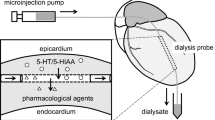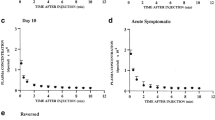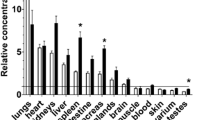Abstract
Kinetics of binding of [3H]PK11195, an antagonist ligand with high selectivity for the peripheral-type (mitochondrial) benzodiazepine receptor (PTBR), was studied in homogenates of cerebral cortex, kidney, heart, and testis of portacaval shunted rats and shamoperated controls. Portacaval anastomosis resulted in a significant two- to threefold increase in the number of [3H]PK11195 binding sites in cerebral cortex and kidney. A reduction in the number of [3H]PK11195 binding sites was observed in testis preparations, while the number of binding sites in the heart remained unaltered. These differences in the response of PTBRs to portacaval anastomosis, in different organs suggest that the physiological function of these receptors and the factors regulating them are modulated by distinct mechanisms. The finding of increased densities of [3H]PK11195 binding sites in brain and kidney following portacaval anastomosis parallels the cellular hypertrophy in these tissues and, together with previous observations of similar increases of these binding sites in brain and kidney in congenital hyperammonemia, suggest a pathophysiologic role for ammonia in these changes. In contrast, the significant loss of [3H]PK11195 binding sites in testicular preparations following portacaval anastomosis together with the known effects of steroid hormones on these sites suggests a role for PTBRs in the pathogenesis of testicular atrophy in chronic liver disease.
Similar content being viewed by others
References
Olsen RW: Drug interactions at the GABA receptorionophore complex. Ann Rev Pharmacol Toxicol 22:245–277, 1982
Gavish M, Katz Y, Bas-Ami S, Weizman R: Biochemical physiological, and pathological aspects of the peripheral benzodiazepine receptors. J Neurochem 58:1589–1601, 1992
Antkiewicz-Michaluk L, Guidotti A, Krueger KE: Molecular characterization and mitochondrial density of a recognition site for peripheral-type benzodiazepine ligands. Mol Pharmacol 34:272–278, 1988
Papadopoulos V, Mukhin AG, Costa E, Krueger KE: The peripheral-type benzodiazepine receptor is functionally linked to Leydig cell steroidogenesis. J Biol Chem 265:3772–3779, 1990
Gehlert DR, Yamamura HI, Wamsley IK: Autoradiographic localization of “peripheral” benzodiazepine binding sites in the rat brain and kidney using [3H]RO5-4864. Eur J Pharmacol 95:329–330, 1983
Davies LP, Huston V: Peripheral benzodiazepine binding sites in heart and their interaction with dipyridamole. Eur J Pharmacol 73:209–211, 1981
Drugan RC, Basile AS, Crawley JN, Paul SM, Skolnick P: Inescapable shock reduces [3H]-Ro 5-4864 binding to “peripheral-type” benzodiazepine receptors in the rat. Pharmacol Biochem Behav 24:1673–1677, 1986
Wang JKT, Morgan JI, Spector S: Benzodiazepines that bind at peripheral sites inhibit cell proliferation. Proc Natl Acad Sci USA 81:753–756, 1984
Anholt RRH: Mitochondrial benzodiazepine receptors as potential modulators of intermediary metabolism. Trends Pharmacol Sci 7:506–511, 1986
Hertz L, Bender AS: Astrocytic benzodiazepine receptors; their possible role in regulation of brain excitability.In Glial Cell Receptors. Kimelberg HK (ed). New York, Raven Press, 1988, pp 159–181
Giguère JF, Hamel E, Butterworth RF: Increased densities of binding sites for the mitochondrial benzodiazepine receptor ligand [3H]PK11195 in rat brain following portacaval anastomosis. Brain Res 585:295–298, 1992
Lavoie J, Pomier Layrargues G, Butterworth RF: Increased densities of “peripheral-type” benzodiazepine receptors in autopsied brain tissue from cirrhotic patients with hepatic encephalopathy. Hepatology 11:874–878, 1990
Rothstein JD, McKhann G, Guarneri P, Barbaccia ML, Guidotti A, Costa E: Cerebrospinal fluid content of diazepam binding inhibitor in chronic hepatic encephalopathy. Ann Neurol 26:57–62, 1989
Butterworth RF, Tonon MC, Desy L, Giguère JF, Vaudry H, Pelletier G: Increased brain content of the endogenous benzodiazepine receptor ligand, Octadecaneuropeptide (ODN), following portacaval anastomosis in the rat. Peptides 12:119–125, 1991
Lee SH, Fisher B: Portacaval shunt in the rat. Surgery 50:668–672, 1961
Therrien G, Butterworth RF: Cerebrospinal fluid amino acids in relation to neurological status in experimental portal-systemic encephalopathy. Metab Brain Dis 6:65–74, 1991
Lowry OH, Rosebrough NJ, Farr AL, Randall RJ: Protein measurement with Folin-phenol reagent. J Biol Chem 193:265–275, 1951
Rao VLR, Agrawal AK, Murthy ChRK: Ammonia-induced alterations in glutamate and muscimol binding to cerebellar synaptic membranes. Neurosci Lett 130:251–254, 1991
Dordal E, Glagov S, Debarros TS: Testicular atrophy in rats with portacaval anastomosis. Arch Pathol 83:49–52, 1967
Lauterburg B, Bircher J: Defective renal handling of water in the rat with a portacaval shunt. Eur J Clin Invest 6:439–444, 1976
Verma A, Nye JS, Snyder SH: Porphyrins are endogenous ligands for the mitochondrial (peripheral-type) benzodiazepine receptors. Proc Natl Acad Sci USA 84:2256–2260, 1987
Lu L, Boxmeyer HE: The selective enhancing influence of hemin and products of human erythrocytes on colony formation by human multipotential (CFUGEMm) and erythroid (BFUE) progenitor cellsin vitro. Exp Hematol 11:721–729, 1983
Stepien H, Pawlikowska A, Pawlikowski M: Effects of benzodiazepines on thymus cell proliferation. Thymus 12:117–121, 1988
Laursen H, Diemer NH: Morphometry of astrocyte and oligodendrocyte ultrastructuer after portacaval anastomosis in the rat. Acta Neuropathol (Berlin) 51:65–70, 1980
Norenberg MD, Lapham LW: The astrocyte response in experimental portal-systemic encephalopathy. An electron microscopic study. J Neuropathol Exp Neurol 33:422–435, 1974
Watson CJ, Sutherland D, Hawkinson V: Studies of coproporphyrin. V. The isomer distribution and per diem excretion of the urinary coproporphyrin in cases of cirrhosis of the liver. J Lab Clin Med 37:1–6, 1951
Brown IA: Liver-Brain Relationships. Springfield, Illinois, Charles C Thomas, 1957, pp 166–169
Basile AS, Ostrowski NL, Gamel SH, Jones EA, Skolnick P: The GABA receptor complex in hepatic encephalopathy. Autoradiographic evidence for the presence of elevated levels of benzodiazepine receptor ligand. Neuropharmacology 3:61–71, 1990
Olasmaa H, Rothstein JD, Guidotti A, Weber RJ, Paul SM, Spector S, Zeneroli ML, Baraldi M, Costa E: Endogenous benzodiazepine receptor ligands in human and animal hepatic encephalopathy. J Neurochem 55:2015–2023, 1990
DeSouza EB, Anholt RRH, Murphy KMM, Snyder SH, Kuhar MJ: Peripheral-type benzodiazepine receptors in endocrine organs: Autoradiographic localization in rat pituitary, adrenal, and testis. Endocrinology 116:576–573, 1985
Regan JW, Yamamura HI, Yamada S, Roeske WR: High-affinity renal [3H]-flunitrazepam binding: Characterization, localization, and alterations in hypertension. Life Sci 28:991–998, 1981
Rao VLR, Qureshi IA, Butterworth RF: Increased densities of binding sites for the “peripheral-type” benzodiazepine receptor ligand [3H]-PK 11195 in congenital ornithine trans-carbamylase deficient sparse-fur mouse. Pediatr Res 34:777–780, 1993
Van Thiel DH, Gavaler JS, Cobb CF, McClain CJ: An evaluation of the respective roles of portasystemic shunting and portal hypertension in rats upon the production gonadal dysfunction in cirrhosis. Gastroenterology 85:154–159, 1983
Gavish M, Okun F, Weizman A, Youdim MBH: Modulation of peripheral benzodiazepine binding sites following chronic estradiol treatment. Eur J Pharmacol 127:147–151, 1986
Anholt RRH, De Souza EB, Kuhar MJ, Snyder SH: Depletion of peripheral-type benzodiazepine receptors after hypophysectomy in rat adrenal gland and testis. Eur J Pharmacol 110:41–46, 1985
Author information
Authors and Affiliations
Rights and permissions
About this article
Cite this article
Raghavendra Rao, V.L., Audet, R., Therrien, G. et al. Tissue-specific alterations of binding sites for peripheral-type benzodiazepine receptor ligand [3H]PK11195 in rats following portacaval anastomosis. Digest Dis Sci 39, 1055–1063 (1994). https://doi.org/10.1007/BF02087558
Received:
Accepted:
Issue Date:
DOI: https://doi.org/10.1007/BF02087558




